/art
Video: GOLDFARMER (2008)

?The video “Goldfarmer” addresses contemporary economical and cultural transformations by interviewing a so called goldfarmer, the player of a popular online game who generates an income by playing. The player has been rendered anonymous by digitally adding the avatar he embodies in the game environment over his face. The phenomenon of goldfarming, that has become a viable form of work, specifically in Asian countries, is used as a model to engage with the transformation of the border between work and play that seems to be characterised by the current dominance of economical paradigms over all other areas of life.
Goldfarmer (2008) DVD Video, 16:9, 13 minutes, Edition of 5, courtesy of the artist and Jim and Mary Barr.
Concept, Camera, Editing: Axel Stockburger
Digital Animation and Motion Capturing: Franz Schubert
Sound Edit: Sebastian Schlachter
The interviewee wishes to remain anonymous
Video: ABSTRACTION (2008)

?At first sight Stockburger’s video Abstraction (2008) appears as the brainchild of the rainbow effects of the star gate in Stanley Kubrick’s 2001: a space Odyssey. To be brought in the giant wormhole is not a “space gater” but 100,000 pictures found in the most comprehensive image search technology on the web: Google Image Search. Kubrick’s abstract colour planes are here replaced with images outsourced from different engines by way of search by keyword approach. Reflecting upon a theme, that of “abstraction”, Stockburger turns this topic of
investigation into a methodological tool used to used to compile images tagged by internet users and following these engines’ recommendations to what can denote “abstraction.” Highlighting similarities and discrepancies of programmes of internet search technologies (for instance Google's ability to laser-focus on the tastes of consumers) and those in the human brain helping it to translate and recognise patterns, the visual content of Abstraction – whose title remains self-referential and nominal by nature – depends on pre-existing indexes of preferences expressed by millions of web users who decide for the artist what can be labelled abstract or not. And like him, while contemplating the flux of Abstraction, we come to realise that for many of them the notion of abstraction is representative of a compendium of references that can be reconciled into a database, an inventory of other subjects’ suggestions.
Stockburger’s interest in translation, whether concerned with word-image interpretation or with media
(transferring from the territory of internet to that of video), seems to be indebted to the legacy of conceptual strategies by Belgian artists René Magritte and Marcel Broodthaers. In particular, the methods of signification in Abstraction can be further explained in the light of some predominant aspects of Broodthaers’s work.
Focusing on how language mismatches words and images, Magritte’s painting The Betrayal of Images (This is Not a Pipe), 1928-1929, or Broodthaers’ Musée d'Art Moderne, Départment des Aigles, 1968-72, are not mere illustrations of an object or a concept. On the contrary, they gently destabilize our mental habits of representation, elaborating didactic classifications, denying images through words, or representing familiar objects juxtaposing a name other than their conventional ones. Similarly to these, Stockburger questions whether the image “abstraction” actually represents what we think it should stand for, and to categorize the many possibilities of meaning, his video follows similar rules of database programs of search engines. However, unlike Magritte and Broodthaers, Stockburger is not interested in juxtaposing text onto an iconic image but in piling up on top of each other as many pictures as possible in order to open up a space for critical reflection for the viewer, him/herself required to make sense of the information accumulated.
Text excerpt from: Diana Baldon, Abstract-o-delica, Abstracts of Syn, Edition Medienturm
>>> download the full text "Abstract-o-delica" by Diana Baldon here >>>
Abstraction, 2008, DVD Video, 7 minutes, courtesy of Edition Medienturm, Graz.
Video: BESTIARIUM (2007)
?Bestiarium addresses the gap between specific audiences and contemporary narrative universes created by multinational companies. An old man speaks the german names of all the different entities present in the multimillion dollar brand universe of POKEMONS. While he has no knowledge of the POKEMON phenomenon he is confronted with a series of names that have been created by an international creative team on the basis of several different languages /greek, Latin, English, Japanes, French, German). It is at once an odd poetic incantation for the uninitiated and a very clear system of information and reference for all those who have comein contact with the POKEMON universe. In this sense the piece attempts to actively present the impact of cultural enterprises within different audience settings and demographics.
Bestiarium, 2007, DVD Video, 30 minutes, Edition of 5, courtesy of the artist.
Installation: BUREAU OF RICH HARVEST - DEPARTMENT CHINA, RCM Museum Nanjing
Axel Stockburger & Nikolaus
Gansterer 2006
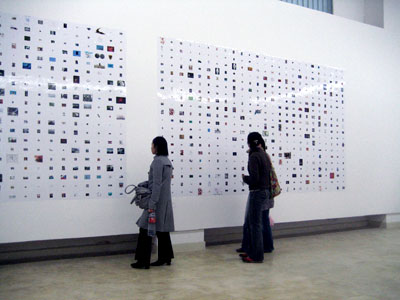
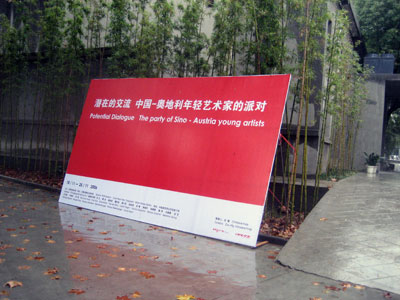
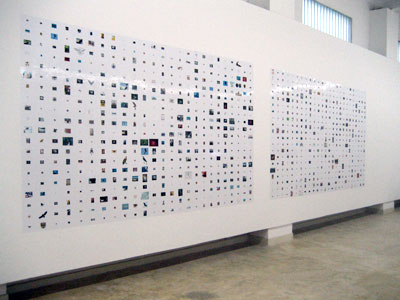
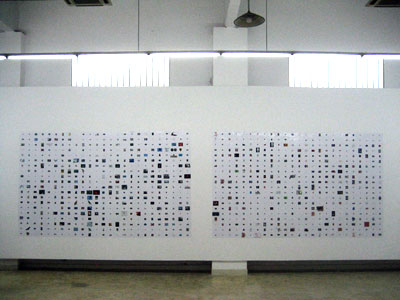
The Installation BUREAU OF RICH HARVEST
- DEPARTMENT CHINA refers to Marcel Broodthaer's
Museum of Eagles. Two image archives derived from Internet search for the
words "Eagle" and "Dragon" are confronted with each other.
The mythical and ancient chinese Dragon is brought in contact with the other
symbol of imperial power, the eagle. The installation consists of 1000 single
images that are arranged in two blocks and was part of the exhibition POTENTIAL
DIALOGUE at the RCM museum in Nanjing, China.
more
images are here
Exhibition: GROUNDED at E:vent
Gallery, London, 28/10/2006 - 19/11/2006
curated by Axel Stockburger
Josh Muller, Nicolas Jasmin, Jonathan Quinn, Nikolaus Gansterer, Douglas Fishbone, Axel Stockburger
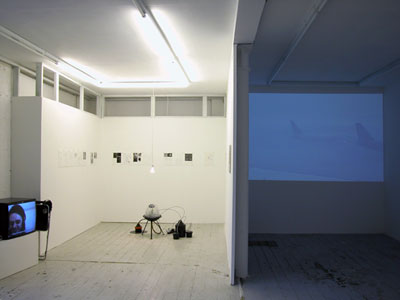
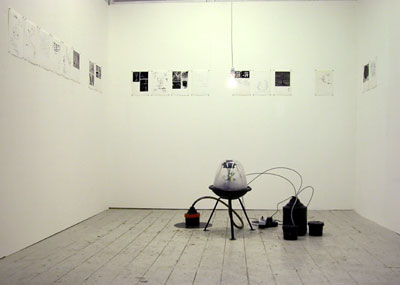
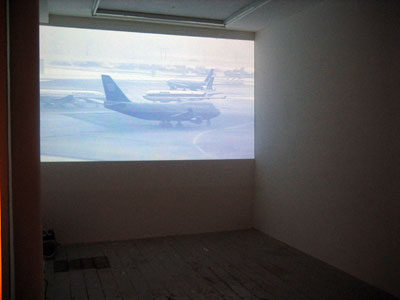
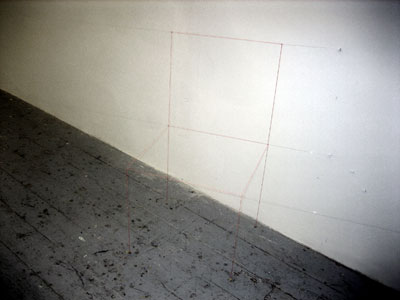


With the increasing presence of digital technologies
in work and spare time, various practices of simulation as well as the translation
of real world phenomena into abstract models are steadily becoming more important.
The title of the show relates, on the one hand to the roots of those abstract
models in physical, „real-world“ processes, on the other hand,
it signifies the situation of a breakdown of traffic or communication. In
the scientific context, grounded theory stands for methods that maintain an
inductive stance based on empirical data. In this sense, the group exhibition
GROUNDED
presents artistic work that critically engages with the production and meaning
of models from very diverse perpectives. Jonathan Quinn, for example, transports
„Wireframe“ models that are often used in the context of 3D modelling
in architecture and engineering with the help of threads and weights into
the physical realm. This simple exchange scrutinises the ontological relation
between model and prototype. Josh Müller’s video „la construction
du ciel“ is based on the complex architectural model of an airport in
deepest winter. All the planes are grounded, no traffic is possible, and the
precise camera movements generate a hyperreal atmosphere that is accomplished
outside the sphere of digital effects. The drawings and installations of Nikolaus
Gansterer aim at the limits and shortcomings of precise scientific modelling
and open a critical perspective towards dominant forms of representation in
this field. His work unleashes a wild, fantastical modelling machinery that
simultaneously maps social, cultural, biological as well as technological
processes and translates them into a unique symbolic form.
Douglas Fishbone relates to a very different type of modelling with his attempts
to construct a complex string of narrations derived from single images downloaded
from the Internet. This practice enables a re-evaluation of the bonds between
images and stories that enable the artist to analyse political formations
and ideological constructions with a strong sense of humour. In his work,
Axel Stockburger engages with the underlying paradigms of contemporary entertainment
media, such as films and computer games. For example, he translates spatial
structures and conventions from simulation games to filmic representation
of physical events in order to analyse the threshold between physical and
simulated processes. Nicolas Jasmin (N.I.C.J.O.B.), who is well known for
his minimal video installations based on appropriated fragments, chooses a
slightly different approach for his new video "The Winners". He
employs architectural photography as a basis for the creation of impossible
constellations of meaning and false connections.
Video: ILSA Factory Database (2006)
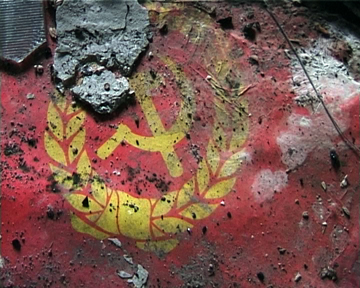
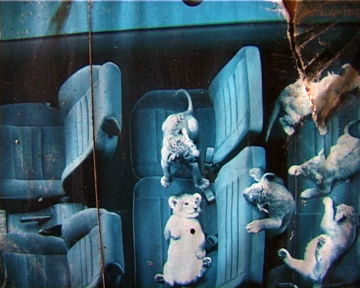

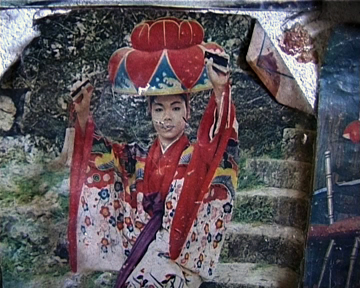
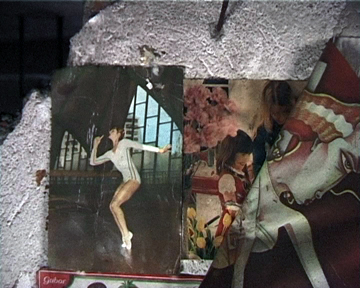
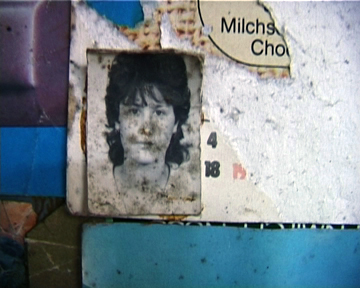
The video was filmed in May 2006 in an abandoned Textile Factory in Timisoara, Romania.Over the years, the workers have generated a kind of image database consisting of an immense amount of clippings from newspapers, product covers, photographys, posters, labels, postcards and stickers on the walls of numerous rooms throughout the factory complex. The camera traces this odd collection of imagery, which evokes products, people, places and dreams and follows the paths of image arrangement. For example there exists an entire wall made up of cars, another wall groups political figures such as the dictator Ceasescu with He-Man and a Boss advert, thereby making fun of power relations and Machismo. Other imagery shows families from south america juxtaposed with postcards from the suiss mountains. The camera movement and animation tries to uncover the connections between different iimages in this veritable database in order to tell a narrative fuelled by the rich imagination of the factory workers at ILSA.
ILSA Factory Database, 2006, DVD Video,
6 minutes, courtesy of the artist.
Concept & Camera: Axel Stockburger, Sound: Mark Schreiber.
Exhibition: Vanishing Point (2005), Starkwhite, Auckland, New Zealand
curated by Jim & Mary Barr

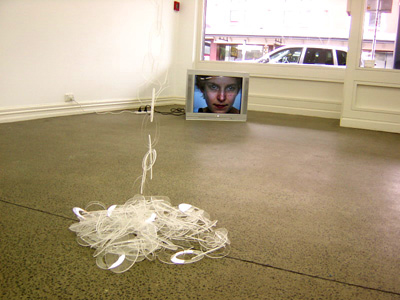
Projection, Upstairs: Boys in the Hood (2005) Installation
View: PSX Warriors Gran Turismo (2001)
Exhibition: FRESH TRIPS (2005), Kunstraum Innsbruck
curated by Michaela Schwentner (MOSZ), Dietmar Schwärzler (INDEX), Wally Salner and Johannes Schweiger (___fabrics interseason) and Annja Krautgasser.
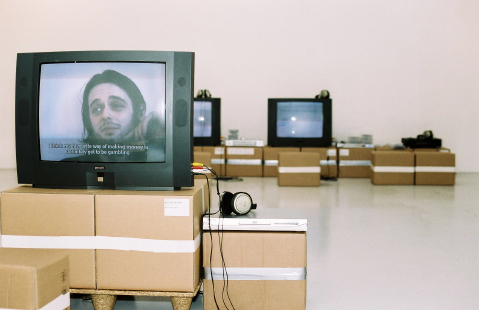
Installation View: Boys in the Hood (2005)
Video: Boys in the Hood (2005)
The Video Boys in the Hood consists of interviews with players of the controversial computer game Grand Theft Auto. The players deliver their perspective of the narrative space of the game by giving detailed descriptions of locations, movements and actions in the game. These subjective accounts of a shared space lead to a diffusion of the borders between ‘real’ and ‘virtual’.

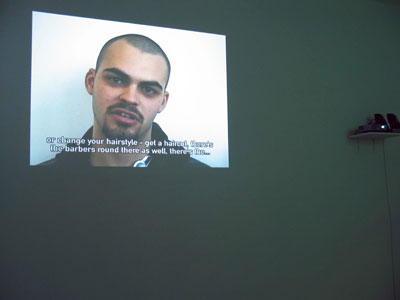
Boys in The Hood, 2005, DVD Video, 60 minutes, Edition of 5, courtesy of the artist.
Exhibition: Save The Day (2005)
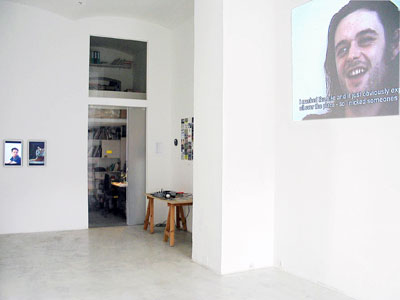
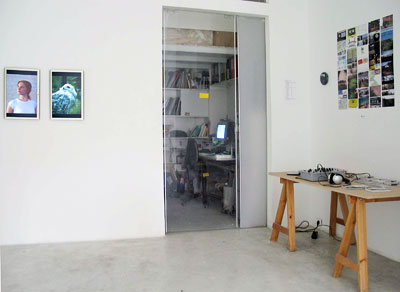
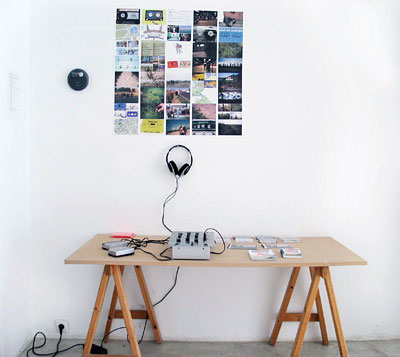
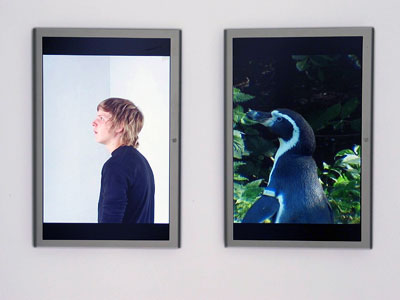
SAVE THE DAY showcased the
works of Douglas Fishbone, Manuel Saiz, Zoe Irvine, and
Axel Stockburger. All four live and work in London, yet they originally come
from New York, Madrid, Edinburgh, and Vienna.The artists develop unique strategies
to deal with the multifaceted media-realities, we are exposed to on a daily
basis, and implement them in intelligent and often playful ways. Douglas Fishbone,
who recently caused a stir with the public installation of 30000 bananas on
London’s Trafalgar Square, uses found footage from the Internet, which
he perfectly integrates into private video narratives. His pieces offer new
ways and intricate forms of confronting media saturation. In his work Manuel
Saiz from Spain primarily approaches the transformative powers of various
technologies in a critical manner. His piece in SAVE THE DAY
is based on video footage of animals in the zoo, whose
movements are meticulously mirrored by actors. This enables a powerful comment
on the culturally defined borderline between different live-forms. The sound
pieces of Scottish artist Zoe Irvine present the audience with various means
of manipulation and direct interaction. In Vienna she shows a new audio installation
that offers live-remixes of her private sound archive. In his work Axel Stockburger,
who has curated the exhibition, deals with the popular phenomenon of computer
games. In a new video piece he presents the adventurous stories of young gamers
and thus fathoms the thin border between everyday llife and mediated experience.
Save The Day, exhibition curated by Axel Stockburger, Gallery Kunstbuero Vienna, February 2005.
Performance: 1+1=1 The Bastard Pop Formula (2005)

1+1=1 The Bastard Pop Formula, DVD Cover, courtesy of N.I.C.J.O.B. and Axel Stockburger.
The Audiovisual Life Performance 1=1=1, The Bastard Pop Formula - Cannibalism in Popular Music has been developed by Axel Stockburger and N.I.C.J.O.B. It comments on the popular phenomenon of Bastard Pop, that has emerged with the ubiquitous online sharing of music. Bastard Pop stands for the combination of 2 entire tracks from two different artists in order to form one new piece of music. N.I.C.J.O.B. creates a dense web of pop hooks and loops with four turntables in dialogue with a live videopiece by Axel Stockburger, that utilises a database of 100.000 artist names which are continually recombined. Performed as part of the exhibition Lebt und arbeitet in Wien II on the 30.06.05 at Kunsthalle Wien, Museumsquartier and at Kunsthalle Graz, on the 28.01.05 for the opening of the exhibition Now's The Time.
Video: Tokyo Arcade Warriors - Shibuya (2005)
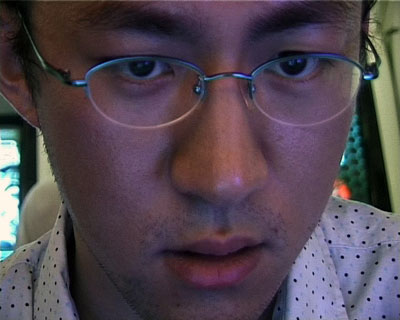
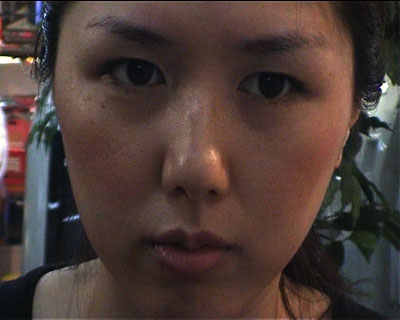
Tokyo Arcade Warriors - Shibuya, is part of an ongoing series of videoportraits of players of video and computer games. It was shot in three different Public Gaming Arcades near Shinjuku/Tokyo. The faces of the players are the only visible evidence of the game being played. Their facial reactions are synced with the sounds emerging from the game consoles.
TokyoArcade Warriors - Shibuya, 2005, DVD Video, 4 minutes, Edition of 5, courtesy of the artist.
Video: Brilliant City (2004)
The film Brilliant City
was produced during a stay in Shanghai with the British Council Artist Link
Program. The title refers to the name of the location, a residential complex
comprised of 25 high-rises in the northern part of Shanghai. It is entirely
shot from the 34th floor of one of the buildings and stages a peeping tom
view of the surrounding city, capturing everyday activities that can be observed
from this vantage point - training soldiers, building activity, traffic, gardening.
The camera hovers above the entire panorama and focuses on details in the
surrounding urban fabric.The film reacts to a particular visual paradigm,
which is well known from strategy and simulation computer games (Sim City,
The Sims) as the so called God View.It is the distanced perspective usually
taken on by city planners, game players
or politicians. In these situations people turn from individuals into patterns
of movement and symbolic activity, and the viewer is turned into an accomplice
of the visual apparatus and the power relations it signifies.
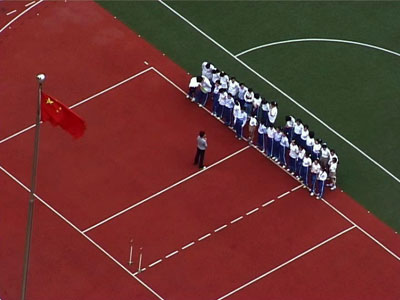
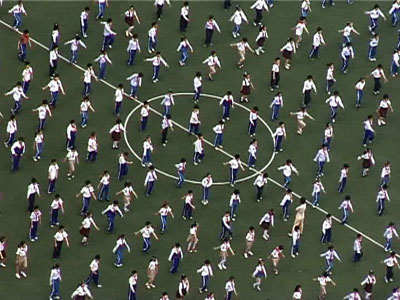
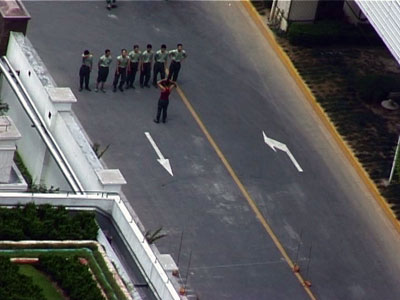
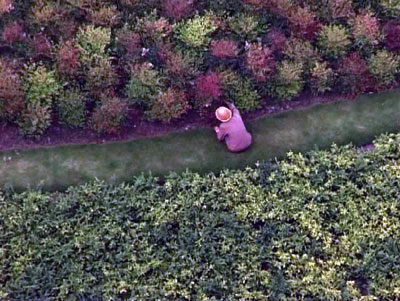
Brilliant City, 2005, DVD Video, 12 minutes,
courtesy of D-Fuse
Concept & Camera: Axel Stockburger, Sound: Mathias Kispert, Still Imagery:
Mike Faulkner.
Installation: GO (2005)
The Videoinstallation GO is recreation of one round of the ancient asian game GO that has been filmed in a public park in Shanghai. GO highlights the specific spatial structure that emerges from the territorial rules of the game.
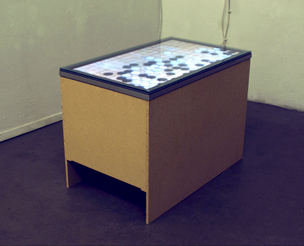
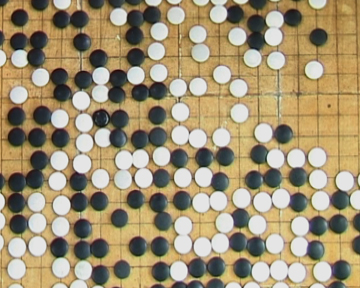
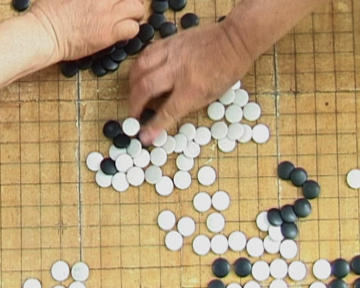

Exhibition views, Axel Stockburger: Spielraum, Praxis Gallery, Vienna, Feb. 2005.
GO, Video Installation, MDF Box 150 cm x 100 cm x 70 cm, Plasma TV, DVD 30 min. courtesy of the artist.
Video: Aleph Series (2000 - 2004) - Love, Hate (2004)

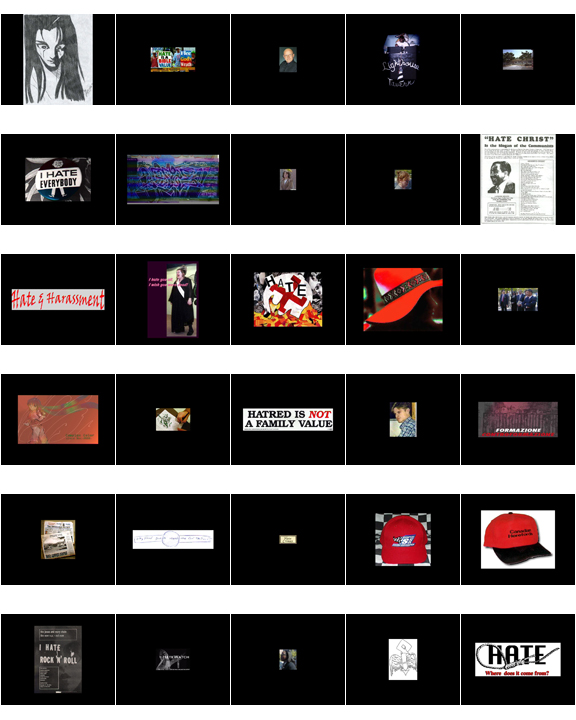 Collection
of images in 1 second of the video Love Collection
of images in 1 second of the video Hate
Collection
of images in 1 second of the video Love Collection
of images in 1 second of the video Hate
The videos Love and Hate are part of a series
of works under the collective title Aleph, that has been started in the year
2000. The title refers to a short story by J.L.Borges, which describes the
discovery of the curious phenomenon of the Aleph. It is a spaceless space
that can only be seen from the stairs leading to the cellar of a friend of
the writer, but it simultaenously opens up an access to the whole universe
of visual information. The Aleph is described as a source of an immense richess
of information which makes it impossible to represent it or capture it in
words. It fascinates and captivates the writer in such a way that it makes
it impossible for him to keep up his work. The Aleph videos Love and Hate
consist entirely of images downloaded from the internet that have been given
the respective titles of Love or Hate. A whole world of the most diverse images
is grouped by these language concepts. From people to books, animals, objects,
landscapes, works of art to pornography it seems that the whole universe of
human pattern recognition and meaning is present. 25 images are shown per
second which goes beyond the borders of human visual perception, thereby creating
a stream of images that cannot be fully decoded or understood.
Marcel Broodthaer’s famous Museum of Eagles, in which he grouped images
and objects from the most diverse fields of life that based on their reference
to the word eagle can be seen as a very early attempt to question structuring
of information. Since this early encounter, machines and programs have been
developed to make sense within a universe of signification. Google could be
seen as one of the most recent attempts to channel this universe of meaning.
The Aleph series is questioning the relation between abstract concepts and
language on the one hand and the sheer explosion of visual information on
the other hand. It is at once an attempt in vain to fix and grasp something
that cannot be pinned down, like the attempt to start drinking the seas dry.
Hate , 2003, DVD Video, 3 minutes, Edition
of 5, courtesy of the artist
Love , 2003, DVD Video, 3 minutes, Edition of 5, courtesy of the artist
Video: WE ACCEPT(2003)

The video We Accept is part of a series of short films entitled the Aleph series, consisting entirely of images downloaded from the Internet. All of these short videopieces target the selection and processing of visual information on a systemic level, regarding the logical structure of search programs and webbrowsers, as well as human perceptive capabilities. About 10000 images have been selected according to their filename ("credit card") and turned into a single frame animation. Images are selected and combined according to their referential context: the title that has been chosen when the image was saved. The sequential animation of all these images in a film represents the vast context of images subsumed to a language based category. Images advertising and symbolising different credit cards and virtual payment systems have become a visual undercurrent of the contemporary state of the world wide web. In "We Accept" they have been taken from the sites and form the content of the video.
We Accept, 2005, DVD Video, 3 minutes, Edition
of 5, Sound: Kid 606: Ass Sratch Fever,
courtesy of the artist.



